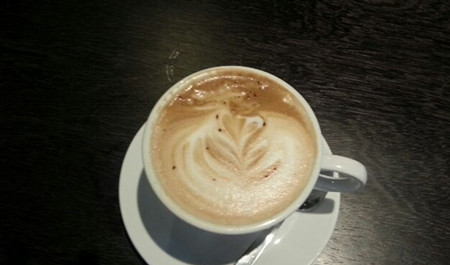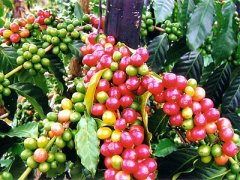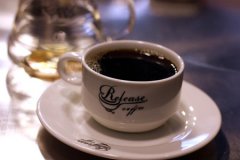Introduction to Fine Coffee beans-- Sumatran Mantenin Fine Coffee Manteau Coffee characteristics

Mantenin coffee beans have a strong aroma and low acidity, with a hint of herbs and earth.
The Dutch introduced Arabica seedlings to Ceylon (present-day Sri Lanka) and Indonesia for the first time in the 17th century. In 1877, a large-scale coffee rust hit the Indonesian islands, destroying almost all coffee trees. People had to give up Arabica, which had been in operation for many years, and introduced Robsta coffee trees with strong disease resistance from Africa. Indonesia today is a big coffee producer, with robusta species accounting for 90% of the total output. Indonesian coffee is mainly produced in Java, Sumatra and Sulawesi, all of which belong to volcanic topography. Sumatra Manning is the only Arabica species that grows mainly on hillsides between 750m and 1500 m above sea level. Mantenin coffee beans have a strong aroma and low acidity, with a hint of herbs and earth. Mantenin coffee beans have large particles and hard beans, and they are prone to defects in the process of planting and processing. After harvest, they are usually subject to strict manual selection. If the control process is not strict enough, it is easy to cause a mixture of good and bad. Therefore, it has become a controversial single product.
The Origin of Manning's name
Mantenin is not the name of the producing area, the place name, the port name, nor the coffee variety name. In fact, it is the phonetic error of the mandheling people in Mandaining, Indonesia. During the Japanese occupation of Indonesia during World War II, a Japanese soldier drank mellow coffee in a cafe, so he asked the owner the name of the coffee. The boss mistakenly thought he was asking where you were from, so he replied: Mandaining. After the war, the Japanese soldiers recalled the "manning" they had drunk in Indonesia. As a result, the coffee merchant shipped 15 tons to Japan, which was very popular. That's how Manning's name got out.
Lin Dong Lintong and Manning Mandheling
The best of the traditional Arabica coffee produced in northern Sumatra is sold as Lindong Lintong and Manning Mandheling. To be exact, Lindong refers to the coffee that grows in a small area southwest of Lake Toba in Lindong District. Lindong coffee is not planted in shade and does not use chemicals. Manning is a broader term that includes Lindong coffee and coffee grown in the northern part of Lake Diari and Lake Toba under similar conditions.
Gold manning, collection manning
Golden Mantenin: the granules of Mantenin coffee beans are larger and the beans are hard, and it is easy to have defects in the production process, resulting in uneven quality. For this reason, producers adopt stricter quality control, and after four times of manual picking of beans, they eliminate defective beans to produce golden mantenin with dark green color, uniform bean appearance and stable quality.
Manning Agedmandheling: it is called "classic" because raw coffee beans need to be stored in the cellar for three years before they are produced. The successful collection beans grind off Manning's inelegant sour taste, and the sour ingredients are ripe and converted into sugar, making the coffee more round and sweeter.
Important Notice :
前街咖啡 FrontStreet Coffee has moved to new addredd:
FrontStreet Coffee Address: 315,Donghua East Road,GuangZhou
Tel:020 38364473
- Prev

Introduction to boutique coffee beans-- the characteristics of Hawaiian Kona Fine Coffee
Hawaii, a beautiful tropical Pacific island, not only produces beautiful scenery, but also produces the famous Kona coffee. Kona is also named after origin. Only coffee beans grown and strictly certified on the southwest coast of Hawaii's main island, 20 miles long and 2 miles wide, 150m ~ 750m above sea level, covering the slopes of Hualalai and Mauna Loa volcanoes, can be crowned with Kon.
- Next

Introduction to coffee bean producing areas-- African Tanzanian boutique coffee Tanzania coffee flavor Tanzania
Well-known representative coffee: Kilimanjaro Tanzania is located in eastern Africa, to the south of Kenya, to the east of the Indian Ocean, with a coastline of 1500 kilometers. Coffee is not the main agriculture in Tanzania and is mostly operated on a small scale. Coffee is grown on the slopes of Mount Kilimanjaro in northern Tanzania near Kenya, and about 70% of it is Elaraby.
Related
- Detailed explanation of Jadeite planting Land in Panamanian Jadeite Manor introduction to the grading system of Jadeite competitive bidding, Red bid, Green bid and Rose Summer
- Story of Coffee planting in Brenka region of Costa Rica Stonehenge Manor anaerobic heavy honey treatment of flavor mouth
- What's on the barrel of Blue Mountain Coffee beans?
- Can American coffee also pull flowers? How to use hot American style to pull out a good-looking pattern?
- Can you make a cold extract with coffee beans? What is the right proportion for cold-extracted coffee formula?
- Indonesian PWN Gold Mandrine Coffee Origin Features Flavor How to Chong? Mandolin coffee is American.
- A brief introduction to the flavor characteristics of Brazilian yellow bourbon coffee beans
- What is the effect of different water quality on the flavor of cold-extracted coffee? What kind of water is best for brewing coffee?
- Why do you think of Rose Summer whenever you mention Panamanian coffee?
- Introduction to the characteristics of authentic blue mountain coffee bean producing areas? What is the CIB Coffee Authority in Jamaica?

